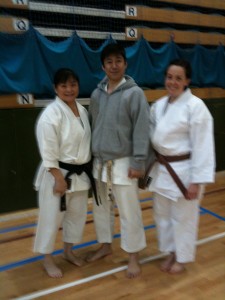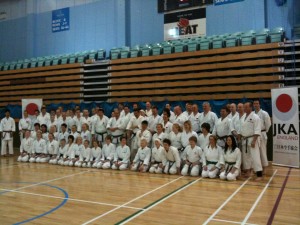 I was just in time for registration before the first training class begins at 3pm. So thankful my karate family extended the local rate of £100 for the 4-day seminar when I presented my JKA passport (a savings of £10 yeah!). Makes a difference when you are scrounging in your uncle’s wallet for cash as you had trouble with the local ATMs.
I was just in time for registration before the first training class begins at 3pm. So thankful my karate family extended the local rate of £100 for the 4-day seminar when I presented my JKA passport (a savings of £10 yeah!). Makes a difference when you are scrounging in your uncle’s wallet for cash as you had trouble with the local ATMs.
2:45p The Sensei(s) were already there and were warming up at the front of the class. Our host Sensei Ohta received a steady stream of congratulatory handshakes from his students for passing his 7th Dan grading 2 weeks ago at JKA Spring Camp in Tokyo, Japan. Sensei Naka, Sensei Osaka and Sensei Mori with their film star and celebrity martial arts status were going through their ritual of stretching before training just like the rest of us. Classes began promptly at 3pm.
The 3-hour training session each day were structured as follows:
1st hour – General all ranks class (GEN)
2nd hour – Kata class, divided into 3 groups, black, brown and color belts (KATA)
3rd hour – Instructor class for 3Dan and above (INST) others continued with kata

(GEN) Sensei Naka began with “posture”, explaining how critical it is to ensure the best delivery of technique and the engaging of proper muscles. He stressed on the importance of maintaining a center axis that runs from the top of our head down our spine to the floor. He had us stand on our tippy toes and bend our knees at a squat without breaking our center axis posture from head to spine. Next, stand back up slowly on our toes without breaking balance and slowly lower our heels to the ground. Now try it again with your eyes closed – it really brings to conscious the effort needed to maintain posture in order to keep balance! He then went onto explain the dynamics of kicking. He had us do several exercises on the floor that helped us track the path of our kick, extend our foot to target and snap back on the retraction. Quite interesting was an exercise doing a “pelvic lift” while lying on our back with our knees bent and hands to our side (like a bench press on the floor). It is supposed to strengthen our gluteus with which we rely on to extend our kicks. He then had us kick one leg at a time from the floor at this pseudo bench press position that concentrates on pushing the gluteus forward to develop the muscle.
(KATA) Sensei Mori worked on ” bassai dai” with the black belts. He emphasized on big motions for the delivery of each technique. He stressed on “zanshin” – focusing on long pauses on key parts and coordinating eye/head position on certain moves. He worked on us to get it to a power house kata.

(INST) Sensei Ohta taught his trademark “gojushiho dai” (per their newsletter). And I can certainly tell why – he had a very effective way of teaching it in less than an hour. First by breaking the kata into parts beginning with “in place” working on upper body motions and then integrating with lower body in motion putting the kata together. All throughout the process emphasizing the nuances of this form – wrist position, target, ending techniques at the same time and rhythm. My litmus test? I actually got it and that awfully painful turn in cat stance? I actually learnt how to do it without breaking balance and killing my ankles. The real treat was Sensei demonstrating the whole kata at the end of class with his signature rhythm and focus! Inspiring.
My legs were jelly at the end of training – can’t wait to see what tomorrow brings. In the meantime, got my luggage back to the Travelodge, grateful for a ride from new karate friends at the camp. A much needed shower, dinner, 3 advils and a good night sleep to be ready for Day 2.
Day 2: 5/1 (Sat)
Walked to the leisure center with the irish contingent in the morning. A good 20mins later, I’m warmed up and ready for class.

(GEN) Sensei Osaka continued with “posture”, focusing on the knee up position when delivering the front kick. He reminded us that the leg tracks the same way for close distance as well as further away. It is the hip position that thrusts forward to bridge the gap. Watch for the common mistake of leaning back (disrupting the center axis). We should crunch the abs when lifting the knee up. He had us partner up and hold hands in front stance supporting each other while simultaneously lifting our front knee. Phew! Not easy. Then continue to snap kick front leg without leaning back and then back leg. Next, we worked on maintaining posture in hamni position together with hip action. From yoi, step forward front stance rising block, then in position other arm rising block snapping hip to hamni. In position kizami zuki (front arm jab) then gyaku zuki (reverse punch). Next, stance practice – step forward oi-zuki front stance, step side empi in kiba-dachi followed by step back knife hand back stance. He stressed on hikite (draw hand) power when executing each technique.
(KATA) Sensei Naka worked on “kanku dai” with the black belts. Such elegance in his demonstration and eloquence in his explanation for the form we all know so well and yet able to rediscover again from Sensei on practically each move. One hour is barely enough!
His first point on the back stance – it is not a step out to back stance but relaxing your support leg letting gravity drop you into the back stance maintaining weight on the supporting leg (keep center axis spine straight). Next point, the hikite hand on the chest angles upward coordinating with the jodan arm position. This is to maintain balance. So in the case of a knife hand block in chudan arm position, the hikite will be at a lower angle; the same would apply for a gedan arm position (like in gojushiho sho or Chinte) the hikite arm would angle toward the floor. Thereafter he cleared up a point on the double feet pivot position (where we punch and chudan block) – we should not pivot in place but rather pivot on our heel shifting body position off the line of attack. Else we will still be in the line of target (say for a dagger strike). Makes good sense. He also stressed the importance of maintaining the draw arm position tight against our body for the side kick to ensure the kick tracks to a proper angle with balance (this also applies for the other 2 side kicks in this kata). Thereafter the pressing block to spear hand should be delivered as though were one technique. The next move on the turn reach hand strike has to be executed in one fluid circular motion, not broken into 2 moves setup-and-strike. This is because he called the set up point a “dead point” that breaks up the power of the technique. After the kicks on the empi, he says not to drop into the strike (which disrupts the center axis posture) but relax the support leg momentarily to thrust forward to the front stance when completing the empi attack. Then, on the last haito-back fist strike, the hand motion tracks in front of the body in a circular wheel motion, not from the top of the head nor the side of the ears as a common bad form. Next point is the lunge position, the back heel is down in kanku dai as opposed to up in kanku sho. Recovery on the turn is a lower than normal back stance that maintains the stride of the lunge. The next back stance is a normal stride for kokutsu-dachi. On the series after the kick and spear-hand, the body should move toward the twist block behind the ear instead of retracting the arm towards the body moving into kiba-dachi. This is because the self defense in this move will not generate enough power to get out of the hold by only using the arm but rather moving forward to break the balance of the attacker at the same time thereby wrenching the arm out of the hold to strike. The back fist strike should be with arms bent in a close position not outstretched. The next chudan strike is extended. Next, for the step through kiba-dachi turn, he reminds us to keep arms close to body when directing the focus on the scoop block. Lastly, the double rising X-block, maintain the wrist together through to the kicks and keep upright body posture on the turn for the finish. Wow! How about that for fine tuning kanku dai.
(INST) Sensei Naka was just charming in this session. Charming and thought provoking with the class. He tossed out the notion of being “instable” in our kata to deliver power and execute technique. Explained the nuances in delivering a punch with a braking hip action (hip rotation), a double hip action (like in hip vibration) and even a triple hip action – we need to practice and discover what works for us. We worked on tekki shodan and tekkie sandan to practice. Many of us trip on trying to think too much doing our kata. We should train for the budo of doing kata without thinking (body memory). Just like trying to trace a triangle with one hand and simultaneously tracing a circle with the other, it takes practice to do so (like kata). Try it. We worked on a series of one arm techniques. He had a drill to step forward oi-zuki, same arm soto-uke, same arm block back fist (like tekki) and choku-zuki. It takes coordination to resist the urge to use both arms alternatively. It is a challenge when paired up with a partner who is attacking at full speed after blocking your first strike with age-uke and returning with chudan reverse punch and jodan choku-zuki and another chudan reverse punch.
He had some fascinating demonstration/thoughts ….
1. When we move forward and extend our arm, we direct with the index or pointing finger; when retracting, we initiate with the ring finger (as in making a fist). This same focus can be applied when we punch directing with index finger and retract for hikite contracting the ring finger)… Interesting concept.
2. Extend your arm with palms open facing downward, when making a fist, do you curl your fingers back into your palm? Or extend your palm forward into your fingers? which is stronger? Surprisingly, the latter (we tested with our partners in class). He talked about the dynamic of the shoulder blade position being better able to support the arm at the joint and fascinatingly also extends the length of our arm.
3. He showed us how sport karate (jumping around in kumite) destabilizes us and is much weaker in sustaining a hit compared to traditional martial arts (heels are on the ground). We also tested this with our partners in class.
4. Sensei demonstrated rotating his hip using upper leg (thigh muscles and hamstrings) while keeping stable the lower leg grounded to the floor, so effortless and completely mesmerizing!
It is a privilege to learn from these elite JKA instructors who spend so much time fine tuning the art and Naka Sensei seem to really enjoy sharing his discoveries and his learning moments with us in the community of karate-kas.
Day 3: 5/2 (Sun)
The Sensei(s) were in good spirits this morning, mingling among the crowd to give some tips to the student and for photo ops. We had a chance to take some pictures of our own (Silvia and I). More importantly, I was able to ask clearance from Sensei Mori for his dojos (especially from the Bay Area) to participate at our June Seminar featuring Mr. Kurasako (6/12). Yeah for our friends at UCSF and Stanford!

(GEN) Sensei Mori also continued on the theme of “posture”, stressing on hikite for both punches and kicks. He kicked off the class with double draw hand to the waist from outstretched jodan joined fist position. We are reminded to keep the back of the. fist parallel to the floor for our draw hands at the waist. He had us paired off and our partner check the position of our draw hand for stability. And for us to affirm the draw hand power compared to that with loosely held elbows.
(KATA) Sensei Osaka worked on “jion” with the black belts. First point on the 2 kicks – knee up position without leaning back and follow through without pause (use gravity and kick retraction to generate speed). Double fist position is slightly angles (check by making knife hand block then close fist). Next, the 3rd age-uke with step in oi-zuki is delivered as though one count without stopping. Next 2 kage-zuki should be done without a setup draw hand (only for teaching beginners) but rely on hikite and tension on supporting kiba-dachi to generate power. The 3 teisho (kidney strike) should not be a pushing movement but with a slight outward inside swing. Reminder on the next back stance to lower into the stance (like kanku dai first moves) instead of stepping out. Important note on the “X” block is tracking the proper arm motion and full extension instead of the worrying about the power and the step; double chudan block not jodan and open hand “X” block is high enough to cover your head. The next 2 inside block should end in hamni and the important note is angle flexibility for a smooth and quick step into the stances. The last 3 series of chudan blocks in kiba-dachi should not have open hand during the moves. All open hand techniques should have a purpose (as in double manji blocks) – do not create a move for open hand without meaning. Implement update on the kata for the last 2 moves where arms set up crossing arms in front of body with open hand for pulling arm.
(INST) Sensei Mori was fiercely passionate that the higher ranks and instructors lead by example the good spirit of training and higher excellence in execution of techniques. He focused on “hikite” for both arms and legs (as in kick back). We did a series of drills for kiage and kekomi to concentrate on proper form. We then worked on “tekki nidan” and went onto drills to practice timing of “sweep” technique.
“Hey,the course is fantastic, even the Americans turn up! “ ~ new friend in JKA England
GRADING EXAMS: Kyu tests were done yesterday. Today’s Dan tests for 3rd Dan and higher were closed doors only open to JKA qualified examiners.
Day 4: 5/3 (Mon)
Last day of training. Everyone seem to be here a little earlier. Sensei Ohta had each country gather to take group phots with the instrructors. The Sensei(s) are all so very accommodating taking pictures and signing posters. Norway had a huge contingent. USA were only the 4 of us (2 from Boston and 2 of us from SF). Friends were excited exchanging contacts … A successful event with a well planned curriculum~


(GEN) Sensei Naka closed on the overriding theme of “posture”. He had a few more exercises to remind us of our center axis and how to leverage momentum and gravity to deliver our techniques with speed and focus. Very important is to work on our flexibility of the ankles. One challenging exercise with a partner – hold hands outstretched with partner, feet together bend knees with body upright (modified yoga chair move). Then step away from partner without holding hands, get into the stance again without falling over. We reviewed the back stance (refer to kanku dai class), maintaining height as we transition from back stance shifting weight to turn and face back direction. Another drill – step back right leg into back stance, turn facing the back and turn again facing front (3 kokotsu0-dachi); kiri-kai retracting the back leg (rt) and step back with left leg into another back stance and end with shift into front stance reverse punch. Next initiate with left leg. The key is to progress to a faster transition on the kiri-kai without stopping but almost dropping into the last kokutsu-dachi (using gravity) to generate speed. Awesome drill!


(KATA) Sensei Ohta worked on “empi” with the black belts. He showed us how to insert hip action into the first down block into the kiba-dachi kage-zuki. He reinforced on points reviewed by Sensei Osaka’s general session and helped us apply it to this kata. He reviewed how to generate the sharp hip movements throughout the kata from the rising punch (braking hip like in reverse punch) to the next gedan berai setup (hip vibration into hamni position) as well as the double punch in kiba-dacho (hip vibration). Attention to the move before kiai – hand and leg move in synchrony with target arm at 45degree angle jodan position to the front. Next, the series of heel palm blocks has to be coordinated with step forward front stance focusing on ankle flexibility and ending at the same time. For the jump turn, we should aspire to get our knees to the chest for the turn. Great stuff!
(INSTR) Sensei Osaka worked on “sochin” and “nijushiho” in the instructor class. (to be continued later).




